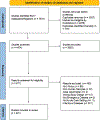Precision acute medical care through "-omic" analyses: a scoping review
- PMID: 40353750
- PMCID: PMC12285246
- DOI: 10.1080/17410541.2025.2499438
Precision acute medical care through "-omic" analyses: a scoping review
Abstract
Background: -Omics technologies - including genomics, transcriptomics, proteomics, and metabolomics - are increasingly used in acute care settings. However, the current extent of this research has not been systematically assessed.
Objectives: To characterize how -omics analyses are applied to acute medical conditions and identify trends, gaps, and implementation barriers.
Methods: Eligible studies included human subjects with acute conditions and used -omics biosample analyses for diagnostic, prognostic, or predictive purposes. Feedback from the SAEM Precision Emergency Medicine Consensus Conference informed the search and inclusion criteria. Studies of infectious diseases were excluded for separate analysis.
Results: Of 7,531 screened articles, 421 met inclusion criteria. Most were observational cohort studies, with single nucleotide polymorphism analysis being most common. Cardiovascular and trauma-related conditions were frequently studied. Only 12.4% of studies included children, and just 7 focused exclusively on older adults. One-third were conducted outside of emergency departments. Many studies addressed diverse, uncategorized acute conditions.
Conclusions: While -omics research in acute care is growing, it remains predominantly observational with limited clinical implementation. Barriers include delayed turnaround times, insufficient EHR integration, and underrepresentation of vulnerable populations. Advancing this field requires cross-disciplinary collaboration, focused research priorities, and investment in implementation studies.
Keywords: Omics; genomics; metabolomics; precision diagnostics; prognostics; proteomics; rapid precision care.
Figures
References
Publication types
MeSH terms
Grants and funding
LinkOut - more resources
Full Text Sources
Other Literature Sources
Miscellaneous



